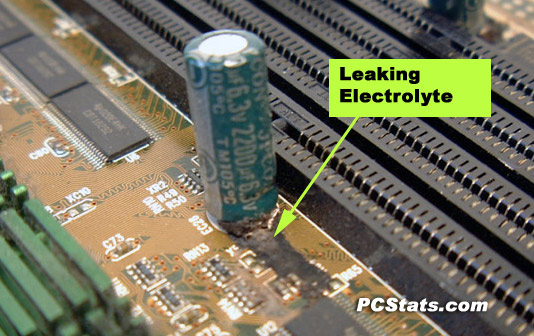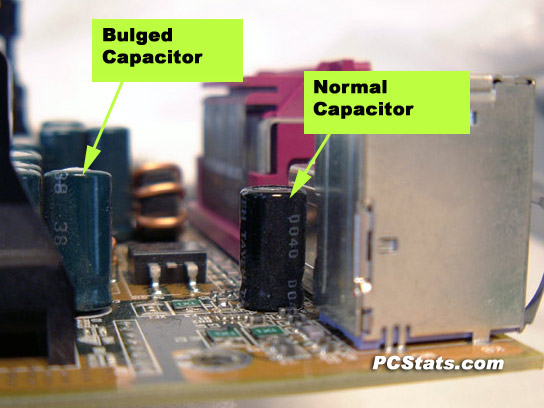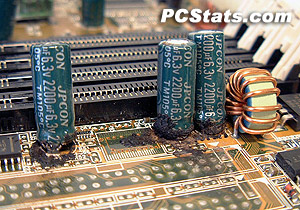While it may be true
that we go through a lot more motherboards at PCstats.com than an average
consumer will in a lifetime, it's the boards that fail which seem to get noticed
most - especially when they force a dreaded system reinstall. This
particular Slot A motherboard was recently retired from active duty because
the computer it was in became unstable, and too unreliable.
This
system had in fact been reinstalled a few times when no physical
capacitor failure was visible, but this last time a quick inspection within the case
had shown disastrous events underway. After ripping the computer apart to
try an diagnose the strange problems which seemed to point to Windows 2000 instability
issues, or possibly bad memory or hard Drive, we found half the low-ESR
(Equivalent Series Resistance) aluminum capacitors on the board in pretty bad shape.
Specifically, every single JPCON 6.3v 2200microfarad, and JPCON 6.3v1500 microfarad capacitor
were either bulged out at the top about to pop, or had blown out
the rubber stopper at the base and were leaking electrolyte (which had turned into
a brown crusty stain on the PCB).
The odd part was that every single JPCON 16v
470microfarad capacitor and all of the TAYEH brand capacitors were perfectly
fine.
At the time we chocked up the failure to a
bad on-board power supply circuit and just assumed something, possibly a MOSFET, had
partially failed and was overloading subsequent components. While I'm not an EE,
that reasoning seemed to explain why half of the 48 capacitors were blowing
themselves up like little aluminum balloons, and the rest weren't.

Fast
forward a few months and while reading through the Toronto Star newspaper it
becomes clear that the odd failure we experienced might not be such
an isolated occurence. We discussed this issue in the PCstats.com Newsletter and while the motherboard
pictured here is about 1-2 years old, it is the only one we have seen until
recently
where capacitor failure was actually
visible.
To
paraphrase the opinions of the author of the Toronto Star
article*
,
the faulty capacitors are suspected to have been rooted in the theft of
an aqueous electrolyte formula which was not copied correctly. If you
were to open up a capacitor you would find thin sheets of
paper and metal rolled up together. The entire assembly is then wetted with an
aqueous electrolyte solution. However, if the formula is not correctly mixed up, hydrogen gas
can apparently build up in the aluminum can with time.

The gas causes the hermetically sealed aluminum
cans to burst, or partially blow out the rubber end cap. If electrolytic capacitors
"dry out" they won't work properly, and that can cause problems with the
computer which can be very difficult to figure out.
*update* December, 2004
Just when we'd more or less forgotten about the previous
issues, we experienced capacitor problems firsthand again, this time in the form
of a FIC AU11 motherboard which had been the base of a previously stable office machine. It died without warning, and upon removing the board we
noticed that 8 of the larger capacitors, specifically four of the GSC 10
volt 2200microFarad capacitors and four of the smaller GSC 6.3v 1000mf capacitors had blown their
tops and leaked electrolyte.
In the same time period we began experiencing difficulties with an ABIT
board, a KT7-RAID. while looking at the board we noticed one partially blown
capacitor and several obviously bulging ones. Not a good sign. The affected
parts were all four JPCON 10 Volt, 2200microFarad capacitors and one of the
smaller JPCON 6.3V 2200microFarad caps.
At the time, the whole faulty capacitor issue had more or less died down, but
this got us to thinking again. What if the lifespan of the faulty
capacitors was coming to an end. Was this going to be just one of a rash
of similar incidents in 2004/2005?

It's a complex problem, and the fact that
businesses have even been set up to replace faulty
mainboard capacitors is an
interesting footnote to just how widespread this issue may be
as older motherboards begin to
show their age. If you know how to solder and read the labels on the
aluminum capacitors, it should be possible to replace the capacitors
yourself - assuming you can find identical replacements at a local electronics
parts supply store. Aluminum capacitors are relatively large compared to other
board mounted components, and in the factories are installed by hand.
We'd like
to know if you have ever had problems with a motherboard due to blown or leaking
capacitors. We have set up a discussion
in the PCstats forums, so if you have experienced this issue or know someone
who has, let us know. Pictures would be good too.
*update* January 2005
It seems that a class
action lawsuit has just been launched against ABIT, one of the few Taiwanese
Motherboard manufacturing companies to actually admit they had a problem with
faulty capacitors at one point. This seems to mirror the class action suit
that was brought against MSI in the summer of last year.
We'll keep an eye on this story and let
you know what happens. It does seem rather harsh that the only company that admitted
they had a problem is getting sued though; this is not exactly going to encourage other
computer companies to be honest about their products, is it?
*The Toronto Star, Monday February 17,
2003. Title: "A Computer Whodunnit?", Author: Rachel Ross. Full story currently
available on Torontostar.com. For more information on this subject
you can visit www.careyholzman.com

